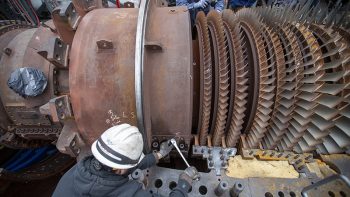Agile gas turbines help meet growing demand for power

If you’ve ever flown on a large passenger jet, you know the feeling during takeoff when those powerful airplane engines press you into back into your seat.
A similar type of engine helps generate affordable, reliable electricity for customers throughout OPPD’s service territory. Natural gas turbines are a key part of OPPD’s diverse and fast-growing generation fleet, and more are on the way to meet rising customer demand.
How they work is surprisingly simple.

Turbine engines inhale filtered air with special blades spinning at extreme speeds. Just like a blowing fan, the blades suck air into the engine for use. Air passes through one set of blades, and then another, and then another.
Two types of blades help the process. Rotor blades connected to a central shaft spin to keep air moving through the engine.
As soon as air passes through one set of rotor blades, they hit another, stationary set of blades known as stator vanes. The stator vanes are angled differently than rotor blades. Their purpose: direct air more efficiently into the next round of spinning rotor blades.
As air flows deeper into the turbine, the spinning rotor-blade shaft becomes wider and closes in on the turbine’s inside walls, which reduces the space available for air.
Forcing the air into a smaller and smaller space compresses it. Pressure builds. Imagine hundreds of people trying to rush out of a movie theater through one door, or water spraying through a hose with a narrow nozzle.
Gas turbines power up quickly
The high-pressure air then spills into the turbine’s combustor, where fuel injectors spray a steady stream of fuel (natural gas or diesel fuel) into the chamber.

The mixture ignites, and the resulting heat spikes the pressure even higher. Gas flowing through a typical power-plant turbine can reach temperatures as high as 2,300 degrees Fahrenheit.
From there, the super-pressurized air-and-gas mixture roars into the main turbine area. In that area, the mixture hits another set of blades, causing them to spin.
The turbine blades do two jobs. They connect to the same shaft as the rotor blades and they drive the engine’s compressor to draw more pressurized air into the combustion section. They also spin a generator, producing electricity.
One big advantage of turbines is their ability to spool up quickly and produce power with little advance notice, said Todd Anderson, lead engineer at OPPD’s Sarpy County Station.
Modified jet engines
Some units can ramp up to their minimum load in about 10 minutes. A typical turbine spins at around 3,600 RPMs. At Sarpy County Station, two “aeroderivative” units are modified jet engines that were originally designed for use in Boeing 737 planes. Other units are much older, dating back to the 1970s.
“Older units are considered heavy-duty gas turbines, they’re very robust,” Anderson said. “With aeroderivative units, everything is light and very fast because they were made for the aircraft industry. You can ramp up a jet engine very quickly, which means you can get them online and make megawatts quickly.”
Keeping close tabs on the machines and conducting regular inspections is critical, given their speed and power. A single broken blade could fly free and shred the rest of the engine, resulting in a catastrophic failure.
OPPD conducts routine borescope inspections of the engines, using a special camera mounted on a wire to view internal components. The utility also works closely with engine manufacturers to determine when to replace parts. Special, large filters help clean air before it enters the engine. Various sensors monitor pressure, exhaust gas temperatures and other aspects of the engine.
“Operators are always watching to make sure we’re within the right parameters,” said Jeremy Kellner, peaking station supervisor at Sarpy County Station.

Grant Schulte joined OPPD as a content generalist in 2022. He is a former reporter for The Associated Press, where he covered the Nebraska Legislature, state politics and other news for a global audience. He is a graduate of the University of Iowa and a proud Hawkeye. In his free time he enjoys running, reading, spending time with his wife, and all things aviation.
View all posts by Grant Schulte >





